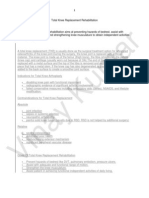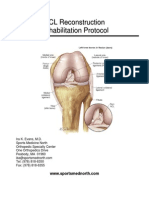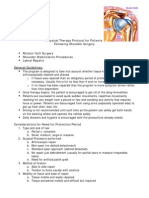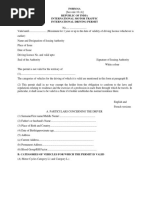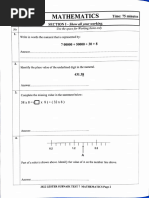Knee Arthroscopy (Meniscectomy) : Anatomy and Biomechanics
Knee Arthroscopy (Meniscectomy) : Anatomy and Biomechanics
Uploaded by
bayan salahCopyright:
Available Formats
Knee Arthroscopy (Meniscectomy) : Anatomy and Biomechanics
Knee Arthroscopy (Meniscectomy) : Anatomy and Biomechanics
Uploaded by
bayan salahOriginal Title
Copyright
Available Formats
Share this document
Did you find this document useful?
Is this content inappropriate?
Copyright:
Available Formats
Knee Arthroscopy (Meniscectomy) : Anatomy and Biomechanics
Knee Arthroscopy (Meniscectomy) : Anatomy and Biomechanics
Uploaded by
bayan salahCopyright:
Available Formats
Knee Arthroscopy (Meniscectomy)
Anatomy and Biomechanics
The knee is a hinge joint at the connection point between the femur and
tibia bones. It is held together by several important ligaments. The
knee is also cushioned during weight bearing by two cartilaginous discs,
called the medial (inside) and lateral (outside) menisci. These menisci
provide shock absorption for the knee during weight bearing. Because
they are soft and rubbery these structures are vulnerable to tearing
when the knee is forcefully twisted during activity. This is known as a
traumatic tear. The meniscus can also break down and tear as a result
of repetitive loading stress over time. This type of tear is called a
degenerative tear.
Both traumatic and degenerative tears can create pain, swelling and locking in the knee. Meniscal tears
come in many shapes and sizes. There are many different categories or names to describe the specific
location or type of tear in the meniscus. Small tears can make it difficult to pivot, run or move laterally.
The larger a tear gets though, the more restrictive it is. Large tears can create a great deal of pain in the
knee making it difficult to walk normally. They occasionally even create a locking in the joint that will
not allow the knee to straighten or bend fully.
Treatment Options
No matter what type of meniscal tear is present your physician
will work with you to determine what the best course of
treatment will be. Small, degenerative meniscal tears are often
treated conservatively with rest, anti-inflammatory measures,
activity modification and Physical Therapy. Many times when the
inflammation is resolved and the patient is agreeable to reducing
the load bearing activity affecting the joint, surgery can be
avoided. If a non-surgical approach is taken the patient must
understand that it is imperative that he or she maintain good
strength in his or her leg and avoid sports or activities that require
pivoting or cutting. If the tear is large or if conservative measures
fail to alleviate the associated pain and joint dysfunction than the surgeon may elect to remove the tear
surgically with the use of an arthroscope.
South Shore Hospital Orthopedic, Spine and Sports Therapy Page 1
in Clinical Collaboration with South Shore Orthopedics
Surgery
When the meniscal tear is removed the surgeon uses an
arthroscopic technique. Two small incisions are made in the front
part of the knee below the knee cap. Through one incision a
camera is inserted so that the surgeon can see the inside of the
knee joint on a monitor. The other incision is used to place a tool
into the joint that will clip and remove the torn piece of cartilage.
While the camera is inside the joint the surgeon uses this
opportunity to examine the rest of the knee to make sure it is
otherwise healthy.
Recovery/Time off Work
It is very important that the patient knows that the recovery process after surgery requires that he or
she be an active participant, performing daily exercises to ensure there is proper return of range of
motion and strength to the knee. There is a large amount of variability in the time it takes to fully
recover from this procedure. It is usually estimated that it will take at least 4-6 weeks for the patient to
feel as though he or she has completely returned to a pre-injury level of activity. Some cases may take
as long as 2-3 months to make a full recovery. People with desk jobs should plan to take at least a few
days off from work. Manual laborers will likely be out of work for at least 4-6 weeks. Recovery is
different in each case. Your individual time table for return to activities and work will be discussed by
your surgeon during post operative office visits.
Post Operative Visits
Your first post-op visit to the doctor’s office will be approximately 7-10 days after the operation. At this
visit your stitches will be removed and you will review the surgery with the surgeon or his/her staff. At
this time you may be asked to make an appointment to begin Physical Therapy. Your surgeon will also
discuss a plan for subsequent post operative office visits at this time, and will have you schedule them
accordingly.
At Home
You should replace your post-op dressing 1 day after the operation. The dressing is no longer necessary
after two days as long as the incisions are dry. Do not remove the strips of tape (steri-strips) that are
across your incision. Allow them to fall off on their own or to be removed at your doctor’s office visit.
You may shower after 2 days, but use a water-tight dressing until your sutures are removed. Bathing
without getting the knee wet or sponge baths are a good alternative.
Medication
Your surgeon will prescribe pain medicine for you after the operation. Please call the doctor’s office if
you have any questions regarding medication.
South Shore Hospital Orthopedic, Spine and Sports Therapy Page 2
in Clinical Collaboration with South Shore Orthopedics
Ice
You must use ice on your knee after the operation for management of pain and swelling. Ice should be
applied 3-5 times a day for 10-20 minutes at a time until pain and swelling are minimized. Always
maintain one layer between ice and the skin. Putting a pillow case over your ice pack works well for
this.
Crutches
After meniscectomy surgery you will need to use crutches to help you walk for a several days. Starting
right after surgery you may put as much weight as you can tolerate on your operated leg while using
both crutches for support. After a few days if you can maintain proper heel toe gait you should switch
to using one crutch while walking. This crutch should be used on the opposite side of the operated
knee. After a few more days you may walk without crutches, but it is very important that you walk with
a normal gait and not limp. If you can not walk normally continue using your crutch or crutches until
you see your doctor or physical therapist.
South Shore Hospital Orthopedic, Spine and Sports Therapy Page 3
in Clinical Collaboration with South Shore Orthopedics
Rehabilitation
**The following is an outlined progression for rehab. Time tables are approximate. Advancement
from phase to phase, as well as specific exercises performed, should be based on each individual
patient’s case and sound clinical judgment on the part of the rehab professional. **
Phase 1 (0-2 Weeks)
Goals
Control Pain and Swelling
Protect Healing Tissue
Restore Joint Range of Motion
Establish Normal Gait Pattern
Establish Hip and Knee Muscle Activation, Especially Quadriceps
Precautions
WBAT with Crutches until normal gait pattern is established
Limit time spent on feet standing or walking
No restrictions in ROM
Recommended Exercises
Range of Motion
Heel Slides 2 Sets of 20 Repetitions
Assisted Knee Flexion/Extension in Sitting 2 Sets of 20 Repetitions
Heel Prop (passive extension) or Prone Hang 5 Minutes
Belt Stretch (Calf/Hamstring) Hold 30 Seconds 3-5 Repetitions
Cycle (minimal resistance) 10-15 Minutes Daily
Strength
Quad Sets 2-3 Sets of 20 Repetitions
SLR *(no Lag)* 2-3 Sets of 10-20 Repetitions
Hip Abd/Add/Extension (against gravity) 2-3 Sets of 10-20 Repetitions
Standing or Prone Hamstring Curls 2-3 Sets of 10-20 Repetitions
T-Band Ankle Pumps 2-3 Sets of 20-25 Repetitions
Guidelines
Use exercise bike daily if possible for 10-15 minutes. Perform Range of Motion exercises 3-5 times a
day. Perform Strengthening exercises 1 time a day.
South Shore Hospital Orthopedic, Spine and Sports Therapy Page 4
in Clinical Collaboration with South Shore Orthopedics
Phase 2 (2-6 Weeks)
Goals
Continued Protection of Healing Tissue
Continue to Improve ROM
Continue to Stress Proper Gait Mechanics
Transition to Weight Bearing/Closed Chain Strengthening
Improve Lower Extremity Flexibility
Precautions
Continue to limit swelling in joint by limiting weight bearing activity
Must continue to stress proper gait
No running or sports until cleared by physician
Recommended Exercises
Range of Motion
Continue ROM exercises from Phase 1 until normal ROM is achieved
Cycle with increased resistance
Add Lower Extremity stretching (Hamstring, Quadriceps, Calf, Glutes, Adductors, ITB, etc)
Cardio
Cycle with progressive resistance
Elliptical at 4 Weeks
Swimming at 4 Weeks
Strengthening
Continue 4 way SLR program (add ankle weight as needed)
Standing T-band TKE
Mini Squat and/or Wall Slide
Heel Raises
Gym Equipment at 2-4 weeks post op if pain free (Leg Press, Ham Curl, Multi-Hip)
Step Up Progressions at 4-6 Weeks post op if pain free (Forward Step Ups) *Forward Step Downs are not
recommended due to increased patella femoral load*
Guidelines
Perform all ROM and Strengthening exercises (except gym equipment) once a day. Do 2-3 sets of 15-20
repetitions. Cycle daily if possible.
South Shore Hospital Orthopedic, Spine and Sports Therapy Page 5
in Clinical Collaboration with South Shore Orthopedics
Phase 3 (6-12 Weeks)
Goals
Avoid excessive joint stress and joint pain
Continue to maximize return of ROM and flexibility
Continue closed chain strength and proprioception
Precautions
Must avoid excess joint stress and keep closed chain exercises pain free
Begin lateral movement and return to activity progression per physician clearance
Begin return to running progression per physician clearance
Recommended Exercises
Range of Motion and Flexibility
Continue Lower Extremity Stretching (Hamstring, Quadriceps, Calf, Glutes, Adductors, ITB, etc)
Cardio
Cycle with progressive resistance
Elliptical
Swimming
May begin return to running progression at 6 weeks post op (outlined by P.T. or Physician)
Strengthening
Continue Progression of 4 way SLR with Ankle Weights
Continue Gym Equipment with progressive loads
Squats to 90⁰
Progressive Single Leg Strengthening (Squat and Lunge Variations)
Step Up Progressions (Forward and Lateral Step Ups) *Forward Step Downs are not recommended due to
increased patella femoral load*
Static Forward/Backward Lunge
Proprioception
Static and Dynamic Balance on Bosu/Wobble Board/Foam/Etc
Star Drill (single leg stance with reach)
Dynamic Progressions
May Begin Plyometric/Jumping Progression (see page 6) at 6 Weeks if approved by P.T. and
Physician
May Begin Speed/Agility Progression (see page 7) at 6 Weeks if approved by P.T. and Physician
Guidelines
Perform stretching program daily. Hold stretches for 30 seconds and perform 2-3 repetitions of each.
Cardio program is recommended 3-5 times a week for 20-45 minutes
Perform strengthening/proprioception exercises 3 times a week. Do 2-3 sets of 15-20 Reps.
Perform plyometric/jumping/agility exercises 2 times a week
Perform return to sport activities as directed by P.T. or Doctor
South Shore Hospital Orthopedic, Spine and Sports Therapy Page 6
in Clinical Collaboration with South Shore Orthopedics
Jumping/Plyometric Progression
Simple Double Limb (6 Weeks Post Op) *Limit 60 foot contacts per workout
Double Leg Hops (forward and backward over line)
Box Jump (6-8 inches max)
*Focus on sticking each landing with good form in frontal and sagital planes. Stress a soft landing with
good eccentric control.*
Complex Double Limb (7 Weeks Post Op) *Limit 90 foot contacts per workout
Double Leg Jump (for distance)
Double Leg Jump (for height)
Double Leg Jump (with 90⁰ or 180⁰ turn)
Double Leg Lateral Jump/Lateral Box Jump (side to side)
Depth Jump (6-8 inches max)
*Focus on sticking each landing with good form in frontal and sagital planes. Stress a soft landing with
good eccentric control.*
Combination Jumps (begin at 18-20 weeks post op)
Repetitive Double Leg Jumps (distance, height, lateral, turns)
Jump for Distance into Jump for Height
Box Jump to Depth Jump
Depth Jump to Jump for Distance/Height
*String jumps together. Focus on quickly moving from jump to jump.*
Single Limb (8 Weeks Post Op) *Limit 100-120 foot contacts per workout
Heiden Hop
Bounding
Single Leg Jumps (distance, height, lateral, 90⁰/180⁰ turn)
Single Leg Box Jumps (6-8 inches max)
Single Leg Depth Jumps (6-8 inches max)
*Focus on sticking each landing with good form in frontal and sagital planes. Stress a soft landing with
good eccentric control.*
Combination Jumps (Single Leg)
Repetitive Single Leg Jumps (distance, height, lateral, 90⁰/180⁰ turn)
Jump for Distance into Jump for Height
Box Jump to Depth Jump
Depth Jump to Jump for Distance/Height
*String jumps together. Focus on quickly moving from jump to jump.*
South Shore Hospital Orthopedic, Spine and Sports Therapy Page 7
in Clinical Collaboration with South Shore Orthopedics
Speed/Agility Progression
*Work with P.T. to establish proper warm-up and cool down before and after each agility workout
session.*
Forward/Backward Sprinting (6 Weeks)
Sprint 50-100 yards at ½ speed 10 reps.
Sprint 50-100 yards at ¾ speed 10 reps
Backpedal 50 yards at ½ speed 5 reps.
Basic Change of Direction (7 Weeks)
*Begin each workout with sprinting and backpedaling 50 yards (2 reps at ½ speed, 5 reps at ¾ speed)
T drill 3 reps at ½ speed
Forward/backpedal shuttle 5/10/20 yard 3 reps at ½ speed
Box drill with shuffling or cutting 3 reps at ½ speed
Advanced Drills (8 Weeks and Beyond)
*Begin each workout with sprinting and backpedaling 50 yards (3 reps at ½ speed, 2 reps at ¾ speed and
5 reps at full speed)
Work with P.T. to develop sport specific drills. Perform drills from previous weeks with use of ball, stick,
etc. Perform drills seen in typical sports practice with supervision.
South Shore Hospital Orthopedic, Spine and Sports Therapy Page 8
in Clinical Collaboration with South Shore Orthopedics
Weight
Time Bearing and Recommended
Focus Range of Motion Precautions
Gait Exercises
Phase 1 *WBAT *Wound Healing *Emphasize 0⁰ ROM *Minimize Joint
0-2 Weeks *D/C *Protect Joint Extension Heel Slides, Seated Assisted Effusion and
crutches *Establish Early *Goal to Achieve Knee Flexion, heel prop, prone Edema
When Gait ROM 120-135⁰ of hang, cycle *Monitor for Gait
Pattern in *Establish Good Flexion Strengthening Abnormalities
Normal Quadriceps *May Have Quad Sets, SLR (no lag), Hip
Contraction and Specific ROM Abd/Add/Extension, Standing or
proper gait Instructions if Prone Hamstring Curl, T-band
mechanics Meniscal Repair Ankle Pump
Phase 2 *Continue *Normalize Gait *Continue to ROM *Must Continue
2-6 Weeks to Stress Mechanics Stress Normal Continue Phase 1 Exercises until to Stress Proper
Proper Gait *Progressive ROM if Still normal ROM is achieved. Start Gait
Weight Bearing Limited Lower Extremity Stretching *Avoid Joint
Strengthening *Begin Lower Program all Muscle Groups. Stress and
Extremity Cycle with increased Resistance Swelling
Stretching Cardio *Emphasize No
Program Cycle with Progressive Joint Pain with
Resistance Exercise
Elliptical at 4 Weeks Progressions
Swimming at 4 Weeks
Strengthening
Progress Open Chain SLR/Hip
Program with Ankle Weights,
Gym Equipment (Leg Press,
Ham Curl, Etc) Squats to 90⁰,
Begin Transition to Single Leg
Strengthening, Step Ups, Static
Forward/Backward Lunge, Etc
Proprioception
Static and Dynamic Balance
with Bosu/Foam/Etc
Phase 3 *Straight *Continue *Continue Lower ROM/Stretching *Must have MD
6-12 Weeks Ahead Preparation for Extremity Continue Lower Extremity and P.T.
Jogging per Return to Sport and Stretching Stretching Program all Muscle Clearance for
Groups Daily
MD Physical Activity Program Daily Return Return to
Cardio
Approval *Progressive Cycle with Progressive Resistance Jogging, Dynamic
*Lateral Strengthening and Elliptical Progressions and
Movement Jumping Swimming Return to Sport.
per MD *Begin Progressive Begin Return to Run Program at 6
Approval Agility Drills Weeks
*Sport Strengthening
Specific Continue SLR Program and Gym
Equipment, Progressive Single Leg
Training
Strengthening, Dynamic Lunge,
Progression Lateral Lunge, Step Up Progressions
per MD Proprioception
Approval Static and Dynamic Balance with
Bosu/Foam/Etc
Dynamic Progressions
Begin Plyometric/Jumping and
Agility Progressions
Progress to Sport Specific Drills
*Reviewed by Michael Geary, MD
South Shore Hospital Orthopedic, Spine and Sports Therapy Page 9
in Clinical Collaboration with South Shore Orthopedics
You might also like
- Letter Combinations in GermanDocument2 pagesLetter Combinations in Germanfairyprincess799No ratings yet
- Luck Be A Lady SinatraDocument5 pagesLuck Be A Lady Sinatra-SCI- Soup75% (4)
- Ortho Services Sports Rehab Clavicle Fracture Protocol Non SurgicalDocument17 pagesOrtho Services Sports Rehab Clavicle Fracture Protocol Non SurgicalKattamedhi Krishnachaitanya KumarreddyNo ratings yet
- Joubert SyndromeDocument24 pagesJoubert Syndromebayan salah0% (1)
- Seminar Report On M-Commerce & Its Security IssuesDocument40 pagesSeminar Report On M-Commerce & Its Security IssuesSameer Yadav100% (1)
- ManageEngine ServiceDesk Plus 8Document576 pagesManageEngine ServiceDesk Plus 8jjprietojNo ratings yet
- Treatment: Home TreatmentsDocument3 pagesTreatment: Home TreatmentsDhimas Reyhan Putra SayudhaNo ratings yet
- ACL Non-Operative ManagmentDocument10 pagesACL Non-Operative ManagmentHammad -ullahNo ratings yet
- Carticel ACI Rehabilitation GuideDocument18 pagesCarticel ACI Rehabilitation GuidematameaNo ratings yet
- Total Knee Arthroplasty (TKA) Rehabilitation ProtocolDocument11 pagesTotal Knee Arthroplasty (TKA) Rehabilitation ProtocolCamille DelageNo ratings yet
- Acl Post Op ProtocolDocument7 pagesAcl Post Op Protocolashrafhusein7220No ratings yet
- Asm Knee Recovery Content OfferDocument6 pagesAsm Knee Recovery Content OffergleridoumarinaNo ratings yet
- South Shore - Protocols - PDF-A - 05.05.2019Document191 pagesSouth Shore - Protocols - PDF-A - 05.05.2019vladi.ciorneiNo ratings yet
- PT OrthoDocument129 pagesPT OrthoHarish Kumar NNo ratings yet
- PT Ortho ProblemsDocument129 pagesPT Ortho ProblemsvinaymanNo ratings yet
- Total Shoulder ReplacementDocument11 pagesTotal Shoulder ReplacementNeicu VladNo ratings yet
- ACL Reconstruction SurgeryDocument8 pagesACL Reconstruction Surgeryjohn hagisNo ratings yet
- Clavicle Fracture Protocol Non SurgicalDocument17 pagesClavicle Fracture Protocol Non SurgicalAlbert MarcuNo ratings yet
- PHY060 Post Op Knee ArthrosDocument8 pagesPHY060 Post Op Knee ArthrosvetermanNo ratings yet
- ACL Reconstruction ProtocolDocument23 pagesACL Reconstruction ProtocolRoberto Tommasini100% (2)
- D M M A: R Ichael C UliffeDocument11 pagesD M M A: R Ichael C UliffeJaime Oso ThompsonNo ratings yet
- Signs and TestsDocument4 pagesSigns and TestsKathryn RedNo ratings yet
- Burn ManagementDocument15 pagesBurn ManagementPraneetha NouduriNo ratings yet
- ACL With Meniscus Repair RehabDocument4 pagesACL With Meniscus Repair Rehabiulianhuludet100% (1)
- Q&A About Total Knee ReplacementDocument4 pagesQ&A About Total Knee ReplacementDrManoj JagarlamudiNo ratings yet
- Acl Rehab ProtocolDocument18 pagesAcl Rehab Protocolapi-256259376No ratings yet
- HEAL THCARE PROVIDERS Kelompok 12Document3 pagesHEAL THCARE PROVIDERS Kelompok 12Novita Dwi WahyuniNo ratings yet
- Knee Athroscopic Surgery Complete RehabDocument8 pagesKnee Athroscopic Surgery Complete RehabdiskraNo ratings yet
- Physiotherapy Rehabilitation Guidelines - Knee ArthrosDocument7 pagesPhysiotherapy Rehabilitation Guidelines - Knee ArthrosmatameaNo ratings yet
- Causes of Knee TightnessDocument4 pagesCauses of Knee TightnessRatnaPrasadNalamNo ratings yet
- Ankle SprainDocument4 pagesAnkle SprainSakthi Annamalai.cNo ratings yet
- ACL ReconstructionDocument24 pagesACL Reconstructionsamabdelaal2000No ratings yet
- Knee Replacement - Physiotherapy After Total Knee ReplacementDocument6 pagesKnee Replacement - Physiotherapy After Total Knee ReplacementShamsuddin HasnaniNo ratings yet
- Post-Operative Exercise Program: Knee Joint Replacement SurgeryDocument16 pagesPost-Operative Exercise Program: Knee Joint Replacement SurgeryRamses DagoyNo ratings yet
- TatalaksanaDocument2 pagesTatalaksanatiffa0711No ratings yet
- Knee Replacement / Arthroplasty: Current PositionDocument20 pagesKnee Replacement / Arthroplasty: Current PositionFerdiriva HamzahNo ratings yet
- Patellofemoral/Chondromalacia Protocol: Anatomy and BiomechanicsDocument8 pagesPatellofemoral/Chondromalacia Protocol: Anatomy and BiomechanicsGirijashankar KhuntiaNo ratings yet
- Patellofemoral/Chondromalacia Protocol: Anatomy and BiomechanicsDocument8 pagesPatellofemoral/Chondromalacia Protocol: Anatomy and BiomechanicsRia PuputNo ratings yet
- After Total Knee Replacement: Discharge InstructionsDocument7 pagesAfter Total Knee Replacement: Discharge InstructionsSamarendra SinghNo ratings yet
- Hip OA: Anatomy and BiomechanicsDocument7 pagesHip OA: Anatomy and BiomechanicsPaul Radulescu - FizioterapeutNo ratings yet
- Freeletics Workout PlanDocument5 pagesFreeletics Workout PlanMiguel OrdoñezNo ratings yet
- Hip Replacement - Physiotherapy After Total Hip ReplacementDocument11 pagesHip Replacement - Physiotherapy After Total Hip ReplacementShamsuddin HasnaniNo ratings yet
- Shoulder Post-Operative Rehabilitation ProtocolsDocument6 pagesShoulder Post-Operative Rehabilitation ProtocolsShrutiNo ratings yet
- Rotator Cuff Impingement PDFDocument8 pagesRotator Cuff Impingement PDFmadaleenNo ratings yet
- Rehabilitation Protocol For ACL Reconstruction Using Double-Looped Hamstring Graft or Donor Allograft Tendon GraftDocument4 pagesRehabilitation Protocol For ACL Reconstruction Using Double-Looped Hamstring Graft or Donor Allograft Tendon GraftDaniel G. A. C.No ratings yet
- Post Operative and Pre Prosthetic ManagementDocument38 pagesPost Operative and Pre Prosthetic ManagementTanzeelah Rajaw100% (1)
- Meniscus RepairDocument14 pagesMeniscus Repairapi-547954700No ratings yet
- Hip Arthroscopy Physical Therapy Protocol NewDocument15 pagesHip Arthroscopy Physical Therapy Protocol NewgleridoumarinaNo ratings yet
- Postoperative Instructions For Knee Arthroscopy, Torn MeniscusDocument4 pagesPostoperative Instructions For Knee Arthroscopy, Torn MeniscusTusan SidhartaNo ratings yet
- Acl Physio ProtocolDocument6 pagesAcl Physio ProtocolAna MorenoNo ratings yet
- Trauma: © Physio Tools LTDDocument1 pageTrauma: © Physio Tools LTDFangYeeNo ratings yet
- Acl R Telerehabilitation V 11 27102022Document42 pagesAcl R Telerehabilitation V 11 2710202255rpy4px5dNo ratings yet
- Completari Artroplastie SoldDocument22 pagesCompletari Artroplastie Soldanasimona284No ratings yet
- Trauma-fractures and sprainDocument26 pagesTrauma-fractures and sprainShahana SunijaNo ratings yet
- Total Hip Replacement (THR) and Its RehabilitationDocument5 pagesTotal Hip Replacement (THR) and Its Rehabilitationfatimah.riazf16No ratings yet
- Tennis Elbow or Lateral Epicondylitis: Key PointsDocument10 pagesTennis Elbow or Lateral Epicondylitis: Key PointsMarliani AfriastutiNo ratings yet
- Information For Patients Following Knee Arthroscopy: Therapies DirectorateDocument6 pagesInformation For Patients Following Knee Arthroscopy: Therapies Directoratepecson1No ratings yet
- Amputation 4th YearDocument57 pagesAmputation 4th Yearshubham raulNo ratings yet
- Role of Physiotherapy in Management of Burns-HshDocument25 pagesRole of Physiotherapy in Management of Burns-HshChristopher Chibueze Igbo100% (2)
- Consent Lumbar MicrodiscectomyDocument9 pagesConsent Lumbar MicrodiscectomyAbhinav GuptaNo ratings yet
- Patients Information For Knee Replacement SurgeryDocument11 pagesPatients Information For Knee Replacement SurgeryUrsulaMcGeeNo ratings yet
- The HKQDocument5 pagesThe HKQgemichan26No ratings yet
- Tips for Everyday Life and Sports With an Artificial Joint: Expert guidebook for dealing with a prosthesis for patients with a new hip or knee jointFrom EverandTips for Everyday Life and Sports With an Artificial Joint: Expert guidebook for dealing with a prosthesis for patients with a new hip or knee jointNo ratings yet
- Type of VariableDocument5 pagesType of Variablebayan salahNo ratings yet
- Rawan Dar Hasan 21810263 Lab 8 The Thevenin Equivalent CircuitDocument5 pagesRawan Dar Hasan 21810263 Lab 8 The Thevenin Equivalent Circuitbayan salahNo ratings yet
- Psychological Reactions To StrokeDocument6 pagesPsychological Reactions To Strokebayan salahNo ratings yet
- Behaviour Change: Patient To PatienceDocument23 pagesBehaviour Change: Patient To Patiencebayan salahNo ratings yet
- Despite: Table 1, 2: Comparison of Mean Knowledge Scores Regarding Sum (Area 1, 2, 3)Document2 pagesDespite: Table 1, 2: Comparison of Mean Knowledge Scores Regarding Sum (Area 1, 2, 3)bayan salahNo ratings yet
- Name: Kayan Salah. #: 21811195Document5 pagesName: Kayan Salah. #: 21811195bayan salahNo ratings yet
- Aquatic Exercise Program 03-16 v3 PDFDocument29 pagesAquatic Exercise Program 03-16 v3 PDFbayan salah100% (1)
- Week Restric Tions Active Ex Passive Ext Active Flex Passive Flex Brace ROM Assistiv e Device W.Bear IngDocument1 pageWeek Restric Tions Active Ex Passive Ext Active Flex Passive Flex Brace ROM Assistiv e Device W.Bear Ingbayan salahNo ratings yet
- Week Restric Tions Active Ex Passive Ext Active Flex Passive Flex Brace ROM Assistiv e Device W.Bear IngDocument1 pageWeek Restric Tions Active Ex Passive Ext Active Flex Passive Flex Brace ROM Assistiv e Device W.Bear Ingbayan salahNo ratings yet
- Facial Electromyography in Newborn and Young Infan PDFDocument8 pagesFacial Electromyography in Newborn and Young Infan PDFbayan salahNo ratings yet
- Knee Arthroscopy With Meniscus Repair Rehab Protocol (Longitudinal / Bucket Handle Tears)Document3 pagesKnee Arthroscopy With Meniscus Repair Rehab Protocol (Longitudinal / Bucket Handle Tears)bayan salahNo ratings yet
- Biomarkers in Acute Respiratory FailureDocument94 pagesBiomarkers in Acute Respiratory Failurebayan salahNo ratings yet
- Nee Arthroscopy Post - Op Rehabilitation ProtocolDocument1 pageNee Arthroscopy Post - Op Rehabilitation Protocolbayan salahNo ratings yet
- Ocio Demographic and Background Data:: Area OneDocument5 pagesOcio Demographic and Background Data:: Area Onebayan salah100% (1)
- Al-Quds University: Students NameDocument75 pagesAl-Quds University: Students Namebayan salahNo ratings yet
- RehabilitationafterLumbarSpineFusion DevelopmentofanExerciseProgram PDFDocument121 pagesRehabilitationafterLumbarSpineFusion DevelopmentofanExerciseProgram PDFbayan salahNo ratings yet
- Severe Paediatric Respiratory Disease: Does Physiotherapy Have A Place?Document45 pagesSevere Paediatric Respiratory Disease: Does Physiotherapy Have A Place?bayan salahNo ratings yet
- Matthe 1 PDFDocument412 pagesMatthe 1 PDFJoão Victor SousaNo ratings yet
- CONTRACT AGREEMENT - Thane 1Document2 pagesCONTRACT AGREEMENT - Thane 1SajidNo ratings yet
- Unit III Role of Transportation in Supply ChainDocument2 pagesUnit III Role of Transportation in Supply ChainRavi KumarNo ratings yet
- Industrial PlanningDocument5 pagesIndustrial PlanningAizen SousukeNo ratings yet
- ExcerptfromtheRamayana1000 600BCEDocument4 pagesExcerptfromtheRamayana1000 600BCEMichaeljohn Rulloda100% (1)
- TopCoder CrowdsourcingDocument39 pagesTopCoder Crowdsourcingjsm789No ratings yet
- Multimeter InstructionsDocument3 pagesMultimeter Instructionsjasonflow902No ratings yet
- Peruvian MusicDocument14 pagesPeruvian MusicManuel González100% (1)
- And Then There Were NoneDocument2 pagesAnd Then There Were Noneteslovanmadalina2No ratings yet
- BAMUL Is India's No.1 Milk Diary. It Processes The Milk and Supplies Milk All Over TheDocument75 pagesBAMUL Is India's No.1 Milk Diary. It Processes The Milk and Supplies Milk All Over TheAmruta Terdal100% (3)
- Hager Company Profile - NewDocument31 pagesHager Company Profile - NewTrung Đỗ NguyễnNo ratings yet
- Topic 1Document38 pagesTopic 1perfect yueNo ratings yet
- TigerTool V3.0 InstructionsDocument28 pagesTigerTool V3.0 Instructionslindkvist.andreasNo ratings yet
- Toledo Vs CADocument18 pagesToledo Vs CARodney AtibulaNo ratings yet
- Kings - ACS-NYC v. Marisela Marrero, Nathaniel Graham - 5.11.23Document42 pagesKings - ACS-NYC v. Marisela Marrero, Nathaniel Graham - 5.11.23fnjeri451No ratings yet
- Big Data For DummiesDocument8 pagesBig Data For DummiesLuis JiménezNo ratings yet
- Form 6A (See Rule 16 (4) ) Republic of India International Motor Traffic International Driving PermitDocument4 pagesForm 6A (See Rule 16 (4) ) Republic of India International Motor Traffic International Driving PermitArshad AliNo ratings yet
- Fukahara Lesson PlanDocument3 pagesFukahara Lesson Planapi-439032061No ratings yet
- ITIL - A Guide To Access Management PDFDocument3 pagesITIL - A Guide To Access Management PDFBabul BhattNo ratings yet
- Q I Module 1 GR 11 Week1Document7 pagesQ I Module 1 GR 11 Week1WilmerNo ratings yet
- International Standard of OccupationsDocument11 pagesInternational Standard of OccupationsNazmus Sakib KhanNo ratings yet
- Math Essay About The First Week of ClassDocument2 pagesMath Essay About The First Week of ClassVictor Del RosarioNo ratings yet
- Math 2140 Lecture 1 2Document20 pagesMath 2140 Lecture 1 2mohammed alqNo ratings yet
- Subnaik 22 Maths Test 7Document14 pagesSubnaik 22 Maths Test 7fecofyleNo ratings yet
- FLIR X6980: High-Speed MWIR Science-Grade CameraDocument2 pagesFLIR X6980: High-Speed MWIR Science-Grade Camera熙槃No ratings yet
- Chapter 18 AP Bio Study GuideDocument6 pagesChapter 18 AP Bio Study GuideHolly SullivanNo ratings yet














